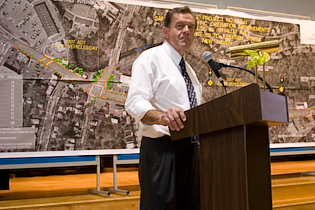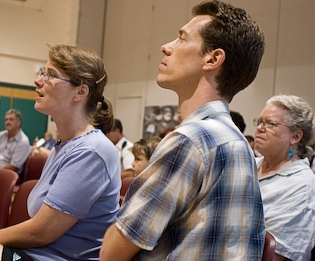 One side sees a four-lane state highway with cars driving 40 miles per hour. The other envisions a calm three-lane road with cars driving 25 and more cyclists and walkers.
One side sees a four-lane state highway with cars driving 40 miles per hour. The other envisions a calm three-lane road with cars driving 25 and more cyclists and walkers.
The two sides came face to face in Westville Thursday night: Over a dozen staffers from the State Department of Transportation (DOT); like project manager Richard Zbrozek (at right in photo) and Westville activists like planner Chris Heitmann, who have joined a citywide “safe streets” campaign looking to slow cars down.
The two sides met for nearly four hours about a $13 million DOT plan, about to begin, to widen eight-tenths of a mile of Whalley, from the 63/69 interchange to Emerson Street. Neighbors have organized to try to get the street narrowed instead.
After four hours of DOT photos, posters, artists’ renderings, wall-size satellite diagrams, and PowerPoint presentations — and news of some last-minute changes aimed at mollifying the neighborhood — fundamental differences remained between the two sides. It came down to a difference in visions. Should the newly Whalley accommodate traffic and driving patterns that currently exist with modest improvements? Or bring about a new way for people to travel, with one lane in either direction for cars and a third, middle lane for left-hand turns, plus separated bike lanes?
 The project — now nearly 30 years in the making — would widen Whalley Avenue by four feet and create four lanes of traffic. It would also include improved sidewalks and crosswalks, more on-street parking, and a range of new landscaping along the strip in question.
The project — now nearly 30 years in the making — would widen Whalley Avenue by four feet and create four lanes of traffic. It would also include improved sidewalks and crosswalks, more on-street parking, and a range of new landscaping along the strip in question.
The Whalley redesign became the subject of intense scrutiny after the death of 11-year old Gabrielle Lee, who died while crossing at an intersection on Whalley. Part of a rising tide of traffic-calming activism in the city, locals recently came together to voice their concerns about the project. The newly formed Coalition for a Livable Whalley would like to see a slower Whalley Avenue that’s more bike and pedestrian-friendly and more aesthetically pleasing.
Four Lanes?
 Thursday night’s Q and A session with DOT project manager Zbrozek (pictured) revealed that one of the neighborhood’s biggest fears is that the creation of additional lanes will increase traffic volume. To hear the DOT tell it, it’s not a question of expansion: They say the road is four lanes already.
Thursday night’s Q and A session with DOT project manager Zbrozek (pictured) revealed that one of the neighborhood’s biggest fears is that the creation of additional lanes will increase traffic volume. To hear the DOT tell it, it’s not a question of expansion: They say the road is four lanes already.
“The street is much too wide,” said Alek Juskevice, of Fountain Street. He was one of several people who called for a narrower Whalley. Juskevice’s vision includes tree-lined sidewalks and a median of flowers. “I don’t see how this [the current plan] is an improvement,” he said, to a roomful of applause.
Zbrozek responded that single lanes in each direction was not a feasible option given the volume of traffic on Whalley. It would create long lines of traffic and force drivers onto side streets in search of alternate routes. He explained that marking four lanes of traffic was simply a recognition of the de facto situation on the avenue, where people drive as though there are four lanes already.
“It is what it is,” he said. “We not expanding it.”
The room responded with muted cries of “Yes you are!”
Safe streets activist Mark Abraham asked if perhaps there could be a compromise between Juskevice’s vision and the current DOT plan. “Can we see traffic slowed to 15 or 20 miles per hour?” he asked, pointing out that the “really successful parts of New Haven” have traffic at that speed.
“I personally feel that we cannot degrade the road,” replied Zbrozek. “To bring it to a single lane, someone else is going to suffer. This is a major arterial. It’s a state highway.”
40 m.p.h.?
Another sticking point emerged from a technical discussion of traffic speed that left many in the audience scratching their heads in confusion and concern.
Zbrozek said that for some streets, the DOT is required by law to plan for the speed that drivers actually drive on a road, regardless of the posted speed limits. For a posted 25 miles-per-hour street like Whalley, that speed would be 40 mph. To the dismay of those gathered, Zbrozek said that when designing the plans for Whalley, traffic engineers took into account drivers going as fast as 15 miles over the speed limit. (The state uses a formula based on how the fastest 15 percent of drivers travel.)
Neighbors wanted to know why the plan wasn’t simply designed for people to drive the posted speed limit of 25 m.p.h.
Zbrozek said that the average recorded speed on Whalley is actually 31 m.p.h. and falling. He said that new traffic calming measures like higher granite curbs would continue to keep speed in check.
 “We’re using more subliminal measures [to calm traffic],” said Jim Norman, a DOT administrator. After the meeting, he listed the redesign’s new traffic calming features: narrower lanes, narrower shoulders, higher curbs, new trees, clearer pedestrian walkways that define the road.
“We’re using more subliminal measures [to calm traffic],” said Jim Norman, a DOT administrator. After the meeting, he listed the redesign’s new traffic calming features: narrower lanes, narrower shoulders, higher curbs, new trees, clearer pedestrian walkways that define the road.
Still, neighbors were asking for more at the meeting. They said they want the road designed for 25 m.p.h.
There’s Still Time
The meeting ended with a plan for the Coalition for a Livable Whalley to to sit down with the DOT to seek a mutually agreeable solution.
The design for the new Whalley is already complete, the permits have all been approved, and preliminary work on the project has already begun. Is there still time to work out a compromise with the neighbors? Is there still room for changes in the plans?
“Yes. I will make the room,” Zbrozek said after the meeting. “I will make the room for that.”
“I’m listening to a bunch of suggestions that I like,” he said.
The shrubbery median? “I love it!”
“I only feel bad about the bicyclists,” Zbrozek said, explaining that he wishes there was a way to do more for them.
Coalition point person Chris Heitmann came away from the meeting with some lingering concerns. He said he doesn’t think that the proposed traffic calming measures would be effective. “I don’t think that will really slow people down,” he said, unlocking his bike for the ride home.
Also, Heitmann isn’t buying the argument that in practice there are already four lanes on Whalley. “The fact of the matter is, they’re still adding a lane of traffic.”
Still, he’s optimistic about further negotiations. “I was really impressed with DOT tonight,” he said. “They really showed they’re listening to people.”